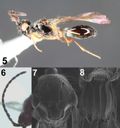Rhagoletis
Rhagoletis
Classification
- Phylum: Arthropoda
- Subphylum: Hexapoda
- Class: Insecta
- Order: Diptera
- Superfamily: Tephritoidea
- Family: Tephritidae
- Subfamily: Trypetinae
- Tribe: Carpomyini
- Subtribe: Carpomyina
- Genus: Rhagoletis
Pronunciation
How to pronounce Rhagoletis: /ræɡoʊˈliːtɪs/
These audio files are automatically generated. While they are not always 100% accurate, they are a good starting point.
Images






Summary
Rhagoletis pomonella, known as the apple maggot, is a significant agricultural pest that primarily infests apples and related fruits, with a complex lifecycle involving larval development within its host and multiple instances of polyandry during mating.
Physical Characteristics
Adult flies average 5 mm (0.20 in) in length, with females being shiny black with white markings and males being slightly smaller. Eggs are fusiform and pearly white when laid, turning cream colored after a short period. Larvae are white or cream-colored and range from 7 to 8.5 mm in length. Pupae are light yellow, turning yellow-brown, and range from 4 to 5 mm in length.
Identification Tips
Adults have a characteristic black banding shaped like an 'F' on their wings and are recognized by their white markings on the thorax. The ovipositor of adult females is horn-like and fully retractable.
Habitat
Widely distributed across North America, especially in orchards where host fruits like apples are abundant. Infestation has been particularly noted in eastern United States and has spread to western states.
Distribution
Endemic to the eastern United States but spread to Oregon, Washington, and northern California. Recorded sightings in Southern Utah, New Mexico, and parts of Mexico.
Diet
Primarily feeds on apples, but may also feed on hawthorn, peaches, pears, cherries, plums, chokeberries, and cranberries.
Life Cycle
The species goes through one generation per year, with adults emerging from late June through September. Eggs hatch within two to six days, and larvae feed for two weeks to over two months, depending on conditions. The pupal stage occurs in the soil.
Reproduction
Females can lay between 300 to 400 eggs during their lifetime. Mating occurs on the host plant, and multiple mating is common. Eggs are laid inside the host fruit, where larvae develop.
Predators
Natural predators include various spider species, ants, birds, and braconid wasps such as Utetes canaliculatus and Opius mellus.
Ecosystem Role
As a pest, they impact fruit production, influencing agricultural practices and crop yields.
Economic Impact
Major pest of apple crops, causing premature fruit drop and unsightly damage, impacting economic viability for apple farmers.
Collecting Methods
- Trapping with baited lures
- Visual inspection of infested fruits
Preservation Methods
- Cold storage at 32°F for 40 days
- Freezing infested fruit
Evolution
Evolved through a shift from feeding on hawthorn to domesticated apples in the mid-1800s, representing an example of sympatric speciation.
Similar Taxa
Misconceptions
Commonly mistaken for other fruit pests, such as codling moth larvae, which feed differently within the fruit.
Tags
- pest
- fruit fly
- Rhagoletis pomonella
- apple maggot